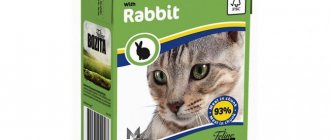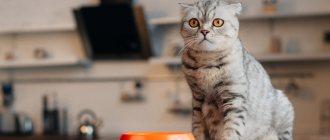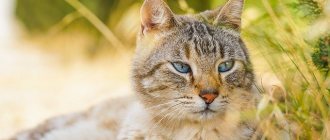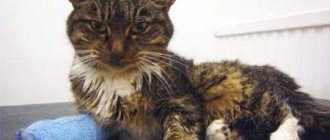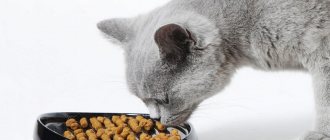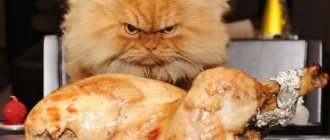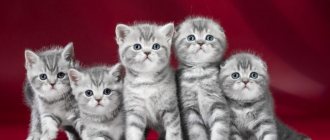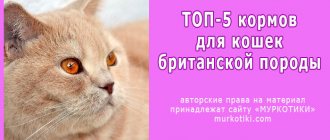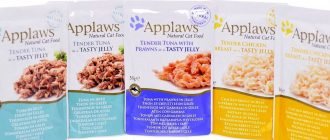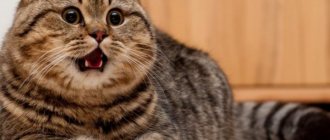Often, cat owners, when selecting food for their pets, come across food on the shelves of pet stores labeled “for cats with sensitive digestion.” At the same time, many people have questions: what animals are these foods intended for? How can you tell if a cat has sensitive digestion?
Let’s try to figure out what features are designated by the term “sensitive digestion”, when there is a need to transfer a cat to a special diet and how to properly organize the nutrition of a cat in need of it.
Protein is an essential element of cat nutrition.
Protein is an essential nutrient, a chronic deficiency of which can lead to irreversible health problems for your pet. This is the main building material for the body, a source of energy. Proteins are composed of amino acids, most of them are essential (taurine, histidine, methionine, arginine, valine, leucine, lysine, tryptophan, isoleucine, phenylalanine, threonine). They are not synthesized from other substances, so they must come from food.
The main food for predators is provided by animal protein, which contains the entire set of amino acids that cannot be reproduced by the body. It is impossible to completely replace meat with protein-containing plant products (for example, legumes). Cats will not get all the nutrients they need from them.
It is especially important for kittens, pregnant and lactating cats to comply with the physiological norm of animal protein consumption. A significant reduction in the protein diet provokes growth cessation, loss of body weight up to critical, fragility, and brittle bones.
Natural diet VS Industrial feed
Industrial feed
Ready-made complete food (dry and canned) is a product made under the strict supervision of specialists from raw materials of animal and plant origin, with the addition of vitamins and minerals. All components of industrial cat food are selected in ratios and quantities that fully provide the animal with the necessary nutrients: fats, proteins, carbohydrates and microelements.
In the case of commercial feed, the manufacturer takes control of the composition. If the production complies with the standards established in the world (FEDIAF or AAFCO), then compliance with the needs is guaranteed by these organizations, which increases confidence in the product. These standards are compiled by scientists and are based on data obtained from research. The standards are regularly updated in accordance with new research data obtained.
Natural (“homemade”) feeding
Feeding at home has its advantages: the ability to independently choose the components of the diet, control the quality of products, and add much more variety. With the help of natural nutrition, you can diversify the table of a sick pet and solve nutritional problems - make it “tasty” and, sometimes, even more effective.
Sometimes home feeding can be cheaper than using commercial feed. However, it almost always requires the use of vitamin and mineral supplements. It is unacceptable to select them yourself, without the help of a veterinary specialist, since errors in the use of additives can lead to diseases over time.
How much protein does a cat need?
The biological need of an adult cat is about 5 - 6 g of animal protein per 1 kg of weight (maximum - up to 10 g with high activity). For example, a pet weighing 3 kg should receive at least 15 g of protein per day.
It is necessary to distinguish between the content of meat products and protein in feed. These are not equivalent concepts.
To clearly show the difference, let’s look at the composition of dry food Fitmin Cat For Life Hairball. The composition states that 87% animal proteins. This does not mean that after eating 100 g, a cat will receive 87 g of protein. For a correct calculation, we need a guaranteed analysis (manufacturers print it on the packaging along with the composition).
For a cat weighing 3 kg, the recommended daily dose is 50 g, of which she will receive (33/100) * 50 = 16.5 g of protein (5.5 g per kg of weight). The daily norm has been met. This, of course, does not guarantee that the manufacturer used high quality products. Unfortunately, legislation regulates only the percentage content of nutrients, and not the consumer properties of raw materials.
The situation is gradually improving: now many private and state examinations are being carried out, during which the actual composition is checked and compared with the guaranteed one. Manufacturers value their reputation, especially in the premium segment, so serious discrepancies with the numbers on the label are becoming less and less common.
What is veterinary food
Veterinary food is a special dietary food, the formulation of which is developed taking into account the special needs of unhealthy animals. Differences from standard diets depend on the type of disease. For example, rehabilitation foods are higher in calories, contain easily digestible ingredients and have a delicate texture. This allows you to reduce the load on the gastrointestinal tract and prevent injury to neighboring tissues after surgery. In addition, such dietary nutrition prevents exhaustion and provides the animal's body with energy and fluid. This is especially important if the pet is weakened, under stress, or eats little food due to being picky.
What should protein be like?
The quality and type of meat are important, as is the quantity. To obtain a full set of vital amino acids, a predator needs a varied diet: beef, pork, poultry, rabbit, eggs, fish, offal. For example, in the composition of the holistic Fitmin Cat For Life Hairball we see: chicken meat, eggs, pork liver, fish.
In cheap feeds, high-quality animal products are replaced with bone meal and grain, so caring owners are increasingly choosing premium lines and holistic feeds (the highest class of feeds). It is more expensive, but when you factor in the costs of veterinarians and medications that are inevitable with poor nutrition, the difference is not too great.
Urolithiasis - diet
It is possible to determine that an animal has urolithiasis after examining its urine. It is also important to understand what type of disease, because the diet depends on this.
- Struvite - for this purpose, urine is oxidized, so they stop feeding food with calcium. Prohibited foods include yolk, milk, cottage cheese and hard cheese. The menu may consist of lean, but boiled lamb, veal or rabbit. River fish in small quantities is also suitable. Boiled chicken liver, oatmeal or rice, in small quantities. Carrots, cauliflower and zucchini.
- Oxalates – remove foods that contain salts, acids and reduce the flow of calcium into the stomach. It is forbidden to eat liver, kidneys, many vegetables, green vegetables and fruits. The menu consists of boiled lean meat, boiled lean fish, in small quantities. Porridges cooked in water, oatmeal and rice. Cabbage, beets, legumes and carrots.
At some points, during urolithiasis, it is forbidden to eat fish. Therefore, if you have questions, you need to ask your veterinarian for advice and find out what the menu should be.
When is low protein food needed?
If lots of protein is good, then why buy low protein cat food? The diet may be required for medicinal purposes: for serious kidney diseases, for example, chronic renal failure (CRF) and a number of other problems. Older, sedentary pets may also be advised to reduce their protein intake. For healthy, young, active animals, restrictions are not only unnecessary, but even harmful.
If a cat does not have kidney problems, then to maintain good health it should receive its daily protein intake (5 - 6 g).
The topic of proper nutrition for pets is complex and extensive. Because of this, confusion often arises. In order not to become a hostage to common misconceptions, it is important to understand: low-protein foods belong to veterinary lines. You cannot be guided by the principle “if it’s medicinal, it’s useful”; it is dangerous to feed it with specialized dried or canned food for the prevention of gastrointestinal disorders, chronic renal failure (CRF), and allergies. Therapeutic, maintenance nutrition is not an ordinary diet; it has a special composition. It is used along with medications for already sick animals during exacerbations and remissions.
Low protein cat food should only be given as prescribed by a doctor after an accurate diagnosis has been established. You cannot make such a decision on your own.
If you notice that something is wrong with your pet, be sure to contact a veterinary clinic; do not self-medicate. Perhaps the cat, on the contrary, does not receive enough protein nutrition with the chosen diet.
How can you tell if a cat has sensitive digestion?
It is easy to notice that all cats have more sensitive digestion than humans. They are very demanding in terms of the composition and quality of food, conservative in their eating habits, and an incorrectly selected diet or a malfunction in the feeding regime can easily harm their health. But in some cats, digestive disorders occur even with minor errors in feeding and maintenance. They may manifest themselves as the following symptoms:
- unstable appetite, picky eating;
- weight loss;
- nausea and vomiting;
- flatulence;
- painful intestinal spasms;
- copious, loose stools;
- soft or loose, foul-smelling stools;
- rare, dry, excessively hard stools.
In addition, disturbances in the digestive system may be accompanied by general lethargy of the animal, deterioration of the skin and coat (dullness and brittleness of the coat, dandruff), and the appearance of discharge from the eyes. If you notice such signs in your pet, you should visit a veterinary clinic to find out the causes of the painful condition. They may be:
- poisoning;
- helminthic infestation;
- infectious diseases;
- stress;
- swallowed foreign object or accumulation of hair in the stomach;
- diseases of internal organs of a non-infectious nature;
- food allergy (inadequate reaction of the immune system to substances that normally do not pose a danger to the body);
- individual intolerance to food components (impaired absorption of certain substances by the body as a result of the absence or decrease in the amount of enzymes necessary for this).
It is necessary to accurately establish the cause of the malaise. The veterinarian will conduct a diagnosis, prescribe treatment, and during it, most likely, will recommend that the owner use a special veterinary diet to feed the cat. It is quite possible that after recovery the animal will also have to follow a special diet. For example, cats with chronic pancreatic disease require a lifelong diet limited in fat and protein to maintain a state of stable remission.
In case of food allergies and individual intolerances, it is very important to exclude from the diet an allergen to which the cat’s immune system reacts, or a food component that is not digestible by the cat.
In such cases, preparing food for your cat on your own can be quite labor-intensive and will require consultation with a veterinarian.
Foods labeled “for cats with sensitive digestion” take into account the special dietary needs of animals that require dietary nutrition and can help the owner properly manage the feeding of a cat that easily develops problems with the gastrointestinal tract.
Why is a low-protein diet indicated for chronic renal failure?
Many representatives of artificially bred breeds have kidney problems. The most common among them is kidney failure. In addition to congenital pathology, its cause may be other diseases, deficiency of beneficial microelements, poisoning, and hypothermia.
A cat that has been diagnosed with this disease needs treatment and special nutrition. Her metabolism is disrupted, the body cannot (fully or partially, depending on the stage) remove metabolic products. As a result, a large number of toxins enter the blood. In the absence of timely, competent therapy, the animal dies. Fortunately, effective treatment methods have already been developed and there are drugs. If the disease is “caught” at an early stage, then a caring owner can provide his furry friend with a long, fulfilling life.
Nutrition in the treatment of chronic renal failure is of considerable importance. It can either help achieve significant improvement or make the situation worse. Typically, veterinarians will prescribe a lifelong low-protein diet.
Reducing protein in the diet inhibits hyperfiltration, which leads to degradation of kidney tissue and reduces general intoxication due to excess urea.
Questions and answers
Is it possible to give dogs food to cats?
Feeding a cat with dog food is extremely undesirable - firstly, because dog food (dry), as a rule, is much harder and larger - i.e. Not designed for feeding cats. In addition, these types of animals need different elements and minerals - giving them food focused exclusively on one of the species will have to “deprive” someone (which, in turn, will affect their health). Also, dog food takes longer for cats to digest and, as a result, causes stomach upset.
Is it possible to feed cats raw foods?
Cats are carnivores and raw meat is necessary in their diet. But before giving it, it must be treated to remove most bacteria. There are several options for “thermal-free” processing:
- place raw meat in a disinfectant solution (¾ water and ¼ food grade (17%) hydrogen peroxide) for a couple of minutes, then rinse with running water and dry/wipe - this is a simple way to remove bacteria on the surface of the meat.
- cut the meat into portioned pieces, place each piece in a plastic bag and deep freeze (in the freezer) - this will destroy the parasite eggs.
Feeding your cat raw fish is not the best idea, because... fish contains many dangers for the animal: from various parasites to cuts to the oral cavity or internal organs (fish bones). If you still decide to treat your pet to fish, then it is better to choose marine species.
Raw vegetables are very beneficial for the animal’s body, but he is unlikely to gnaw them, so they need to be grated on a fine grater and mixed into the “main product”.
Principles of nutrition for kidney disease
The goal of the diet is to reduce the load on the kidneys and improve metabolism. Simple, proven rules will help you achieve this:
- Protein restriction. What protein products should be included in feed for chronic renal failure? First of all, they should be easy to digest. The best sources are dietary chicken, rabbit or lamb. Pork is acceptable, but it is better to avoid beef. It is impossible to completely eliminate animal protein, otherwise the sick pet will begin to lose weight, which will only worsen its condition.
- Minimum phosphorus. Since an excess of this substance is excreted through the kidneys, with chronic renal failure there is a risk of developing hyperphosphatemia. Controlling the phosphate content in the diet is a basic rule, since a sharp increase in their level in the blood leads to fatal consequences.
- Drinking enough. To eliminate the risk of dehydration, your cat should always have access to clean drinking water. It is important to monitor the quality of water; the fewer harmful impurities it contains, the better. Make the best use of filters. You need to change the water in the drinking bowl at least once a day. It’s better to do it twice so that it doesn’t stagnate and accumulate contaminants settling from the air.
- High-calorie nutrition with a balance of beneficial microelements (calcium, omega fatty acids, potassium citrate, antioxidants, vitamins C, E, A, D3, iron, plant fiber). If the weight dynamics are negative, then there are not enough calories (the average norm is at least 3500 kcal per day).
- Accurate calculation. Food portions must be measured every day, adhering to the prescribed therapeutic norm. It is not recommended to overfeed or underfeed cats with chronic renal failure. They need to eat at least 5 times a day, in small portions. Sick pets often have decreased appetite. To prevent them from starving, you can try feeding them by hand or in a playful way. Another way is to slightly warm up the food in the microwave until it is at a comfortable temperature for your cat. Of course, you shouldn't force feed. This will lead to unwanted stress.
If possible, exclude:
- fat meat,
- dairy products,
- seafood,
- salt,
- grain crops.
cats
Castrated cats , as a rule, begin to gain weight (despite the fact that they feed him “as usual”) and become prone to urolithiasis - the fact is that after castration the animal’s metabolism changes and it becomes less mobile.
To prevent negative changes in health, you need to adjust your diet:
The most popular option is ready-made food “for castrated cats” (such diets are available in all price segments).
If the owner decides to feed the pet exclusively natural food, then the diet must include: boiled dietary meat (poultry, rabbit, veal) and cereals (barley, buckwheat, wheat, corn, oatmeal, rice - for example, in the form of porridge cooked in meat broth ); once or twice a week, boiled offal (heart, liver, lungs, stomachs) is recommended; try to give him vegetables (carrots, bell peppers, beets and various cabbage) grated on a fine grater and added to meat or porridge (since the cat is unlikely to eat them of his own free will) But it is extremely undesirable to give fish to neutered cats (not more than once a week, a little and only boiled seafood) - it provokes urolithiasis.
Feeding twice a day with small portions of food is recommended.
Natural food or dry food
There is a heated debate among cat lovers about what is better: natural food or ready-made crackers. Adherents of both camps find reasons for and against their views.
| Ready-made medicinal food | Natural nutrition |
| + more convenient to use, + easier to measure portions, + does not spoil for a long time, + no need to cook. | + the composition is precisely known, + always fresh food, + it is possible to exclude or add certain ingredients according to the cat’s taste. |
| — errors in the composition are possible (inconsistencies with the information on the packaging), - protein content cannot be precisely controlled, - difficult selection. | - it is difficult to maintain a balance of nutrients, - regular purchase of products, - waste of time on preparation. |
It is important to remember that your doctor should have the final say. Only he has sufficient education and data from all animal studies to prescribe a competent diet.
In practice, most veterinary specialists recommend ready-made food, since it is rare that an owner has enough time and patience to regularly prepare food for their pet from natural products. It’s easier to buy a ready-made dryer that already has everything you need.
If the pet refuses to eat, then with the permission of the veterinarian you need to change the food or the selected diet.
It happens that a cat does not like a low-protein diet. The most capricious individuals may even “go on a hunger strike” - as a matter of principle, they will not eat anything new. For some time this is not difficult for them, since their appetite is still reduced. In most cases, allowing a dog to starve is more harmful than allowing a stubborn furry to eat its usual food.
Normal protein intake for chronic renal failure is not as bad as an excess of phosphorus.
Eating high-fat foods is a good way to provide energy for your furry pet without increasing phosphorus levels. However, a diet rich in fat is not suitable for animals with pancreatic diseases. In such cases, you need to choose cat food that is low in protein and fat.
Diet while overweight
Extra pounds can cause diabetes. To maintain weight and get your pet to lose weight, it needs to be fed properly. Not all cats are overweight. If a person thinks that his pet is fat, he needs to be put on a diet. For such cases, there are dietary cat foods. But before putting a cat on the right diet, ask a veterinarian for advice.
Losing weight takes a long time, and unforeseen complications can occur. In many cases, a vegetarian diet is used, and the pet’s characteristics are also observed. There are several conditions and tips that will help you create a menu for losing weight for a cat:
- To reduce daily calories, you can reduce the number of servings or the number of feedings per day. It is advisable to create a menu with the help of an experienced animal nutritionist.
- The cat needs to be given more water, because water has properties that help quickly saturate the body.
- Increasing low-calorie supplements, which also help saturate the pet's body. For example, use the fortiflor nutritional supplement. Cat food can be eaten by kittens and adult cats; the drug does not cause diarrhea and has a beneficial effect on the intestines.
- If your veterinarian allows it, you can increase your cat's physical activity and play with her more.
- The amount of food must be carefully monitored and measured to ensure that the food is not overloaded with calories.
- If the owner keeps more than one cat in the house, then they should be fed separately. So that the pet who is on a diet cannot get a large excess of food, because he will not only gain extra pounds, but may also vomit.
- Do not give animals treats that contain fat. Only low-calorie treats should be given, such as corn, beans or carrots.
- In order to avoid frequent visits to the doctor, you can weigh your pet yourself.
- Food should not cause allergies in cats, as this will lead to severe poisoning. Therefore, be sure to consult a veterinarian before starting a diet.
To improve your pet's weight, you need to keep it on a diet for 8-12 months. The maximum amount of weight loss per day is 125-250 grams.
Following a diet menu will be difficult for both the owner and his pet. If the owner wants his cat to be healthy, he needs to give attention and care to the pet.
How much should you limit protein and phosphorus?
There is still no clear conclusion on the optimal amount of animal protein consumed for kidney disease. The situation is complicated by the lack of large-scale studies that would give reliable results. Experts are discussing this issue, but general recommendations have been established: therapeutic diets have been developed for different stages of CKD. Their protein content is reduced to 58 - 82 g of protein per 1000 kcal for cats. When making calculations, the doctor must take into account the patient’s condition and make adjustments based on diet tolerance.
The phosphorus content in therapeutic diets should not exceed 1.35 g per 1000 kcal. In this case, it is necessary to monitor blood plasma parameters. If, through dietary restriction, it is not possible to achieve normal concentrations, hyperphosphatemia persists (0.9-1.5 mmol/l in the second stage of CKD and 1.6-1.9 mmol/l in the third), it is necessary to add drugs that bind phosphorus in the intestines.
All medications must be prescribed by a doctor based on test results.
If the animal is undergoing treatment, then it is necessary to monitor the response to complex therapy. This will allow you to correctly assess his condition and, if necessary, optimize the nutrition process and the doses of medications taken. When improvements occur, the diet cannot be stopped. If chronic renal failure is already an established fact, then your doctor will recommend that you completely switch your pet to premium low-protein cat food.
Despite the obvious differences (and even frequent psychological incompatibility) between dogs and cats, the main principles of feeding both remain unchanged and common to both “races” of pets. But about the differences - in more detail.
If canines are both carnivores, herbivores and scavengers, then cats - domestic and wild - are almost pure predators. Cats are not omnivores, and even less adapted than dogs are to eating all kinds of cereals, pasta and everything else that their owners can think of (not to mention ready-made food). Dr. Ian Billinghurst calls cats “reluctant carnivores,” pointing out that their digestive system and the entire body as a whole are built in such a way as to function precisely on food of animal origin. In addition, cats are created to obtain almost all the moisture (water) necessary for the body from food; they rarely drink (which makes feeding them dry food completely inadequate). Therefore, the “menu” of cats should primarily consist of frames of small mammals (I think it is unlikely that these will be laboratory mice and rats, but at least you can focus on various poultry, rabbits, etc.).
Expressed in terms of nutrition, a cat's diet, compared to a dog's, should contain much more animal proteins and fats and much less plant products , incl. and vegetable fats and oils. A cat needs slightly less bones than a dog, and more of all kinds of offal, especially liver.
Since a cat's diet should consist almost entirely of animal products, the task of a cat owner is simplified compared to those trying to maintain a BARF diet for their dogs. But switching a cat to this natural diet is a real hassle. That's why it's better to start feeding your cat natural products from an early age.
The main components of the BARF menu for cats are the same as for dogs, but the proportions here are different:
75% - meat and meat bones 15-25% - offal (liver, heart, stomachs) 0-5% - ground vegetables The rest - additives and vitamins
Meat bones . Unlike dogs, cat meat bones should be meatier. If for an adult dog the content of meat and bones in a meat bone should be approximately 1:1, then cats should have twice as much meat, i.e. meat and bones should be in a 2:1 ratio, respectively. This proportion can be achieved either by selecting special meat bones, or by adding pure chopped meat to the meat bones. The most convenient option for meat bones for cats are carcasses of chickens and other poultry (backs, breasts, necks).
Offal. With this ingredient in the cat's diet, everything is very clear. Unlike dogs, cats need a slightly larger variety of internal organs, which they would eat first if they had the opportunity to hunt small animals on their own. Liver, heart, gizzards (unpeeled chicken, for example, are also suitable) - this is the main set that should be given.
Vegetables . For cats, vegetables must be ground, achieving a consistency similar to that found in the stomachs of small animals that cats feed on. Vegetables are mostly green (not by ripeness, of course, but by color: leafy vegetables, cabbage, cucumbers, etc.) and not starchy (that is, potatoes disappear immediately and forever). All vegetables and fruits selected for your cat should have a low glycemic index. Remember that vegetables play a much smaller role in a cat's life than in dogs.
Supplements and vitamins . The cat is given the same vitamins, fatty acids, etc., as the dog. The principles for calculating dosages of vitamins and minerals for cats are the same as for dogs - see the corresponding table. The only important difference is the source of essential fatty acids. The fact is that cats do not have a mechanism for converting inactive forms of these acids into active ones, so it is vitally important to provide cats with sources of essential fatty acids that contain them in their active form. Moreover, all these sources must be of animal and not plant origin. Raw meat, especially red raw meat, and eggs are good sources of the active form of Omega-6 for your cat. And cod liver oil and salmon oil are excellent sources of Omega-3. In case of inflammatory diseases (joints, or colds or infectious diseases), the recommended dosage of fish oil for a cat is from 1/2 to 1 teaspoon per 4.5 kg of cat’s weight, salmon oil is also from 1/2 to 1 teaspoon spoons per 4.5 kg of weight. When switching to a natural diet, a course of probiotics and enzymes is required (about switching to BARF, read the “dog” article, adjusted for the above proportions and cat characteristics).
I will not dwell separately on the principle of transferring a cat to BARF. I do this for several reasons. First of all, I don’t have a cat, and I can’t even imagine how she might react to an offer to try a completely new food. Secondly, I outlined in such detail the principles of translation, possible concerns, pitfalls, etc. in the article “BARF for Beginners”, I don’t see the point in repeating all this here. Everything that is written there is equally true for cats.
Below I present an approximate weekly menu for a cat (how convenient, right?), which is published in Ian Billinghurst’s book “BARF Diet for Dogs and Cats.” Remember. That this is just one of hundreds of options that you yourself will be able to compile and use over time in your long joint human-cat life ;o)
Monday Morning: raw meat bones - chicken wings or necks Evening: Twisted beef in a meat grinder with ground vegetables and egg. Additives: fish oil (can be added directly to vegetables), kelp (seaweed), alfalfa and B complex vitamins.
Tuesday: Morning: Raw meat bones Evening: Chopped liver and heart with ground vegetables. Additives: kelp, alfalfa, vitamin E
Wednesday: Morning: Raw meat bones (wings and necks) or twisted chicken backs Evening: Twisted beef (medium fat, not lean) with egg and ground vegetables.
Thursday: Morning: Twisted lamb, pork neck or veal tail Evening: Raw fresh fish. Additives: fish oil, vitamin E, kelp.
Friday: Morning: A piece of rabbit (for example, back, breast) - can be ground in a meat grinder. Evening: Raw meat bones with pieces of heart and kidneys, and ground vegetables. Supplements: fish oil and vitamin E.
Saturday: Morning: Raw meat bones - chicken wings or necks. Evening: Twisted turkey meat with added egg. Additives: vitamin E and fish oil.
Sunday: Morning: Twisted lamb, pork neck or veal tail, with some ground vegetables added. Evening: Large chunks of beef for chewing.
A few comments on the above example menu: 1) This menu is just an option that should help you understand the idea of BARF feeding your cat. What exactly, at what time of day, and on what days of the week you will feed your cat is up to you. By the way, the menu does not include live bio-yogurt, which can actually be given from time to time by adding to vegetables. 2) The menu shows different types of raw meat bones, which the cat is fed on different days throughout the week. You can choose another option - mix different types of meat bones and give them in this mix every day. The third option is that you can feed one source of bone meat for a week, and then the next for a week, and so on. For example, this week you feed your cat only chicken, the next week only beef, the third week pork, etc. Feeding raw fish does not have to be limited to one day a week if your cat loves fish. Although fish should not be the main thing on the cat's menu. Don’t try to complicate your task if you don’t have beef today, and yesterday you already fed the cat chicken - feed it again today with chicken, and if necessary, tomorrow, and then you can feed it beef for the same number of days in a row. Start from what is available to you and remember that nutritional balance is achieved not in one feeding, not in one day, or even in a week - but over several weeks. 3) This menu does not include a “fasting day”, however, if it is necessary, you can fast your cat from time to time. The benefits of fasting for animals are written in a separate article (it is addressed to dog owners, but its content is exactly the same for cats). 4) You can feed your cat a “multi-mix” , preparing it for a week in advance. Here's how it's done:
Multi-mix for cats consists of:
70-75% raw meat bones 15-20% offal 10% other additives 0-5% vegetables and fruits.
Ingredient #1: Raw meat bones. 3.4 kg of raw meat bones, well minced in a meat grinder: - chicken frames, necks and wings, - lamb ribs or beef ribs, - any other meat with bones that you have Meat and bones can come from different animals, for example, turkey meat, and rabbit or lamb bones. If your cat is not allergic to any meat products, then do not be afraid to mix: the more varied the mix from different sources of meat and bones, the better. Or you can make mono-mixes - so that each week there is some kind of source of meat and bones, but in different weeks - different sources, for example - chicken this week, beef the next, then turkey, etc. d. Remember that maso and bones should be in a 2:1 ratio for a cat (2 parts meat - 1 part bones). Remember also that cats require fattier meat than dogs. This is especially true for young, active, pregnant and lactating cats. Of course, if your cat is a little fat, then it is better to give meat that is not very fatty, so as not to provoke further weight gain.
Ingredient No. 2: By-products. 680 g finely chopped or ground liver, kidneys, hearts and gizzards. Remember that all these “spare parts” must be bought from trusted places and be clean (free from parasites) - as a rule, when you buy raw livers and so on, it’s already clear from their appearance how healthy they are.
Ingredient #3: Other additives. 3 whole eggs, including shells (washed, of course) 43 g salmon oil 114 N live yoghurt or, instead, an equivalent amount of probiotics 57 g kelp powder (seaweed can be bought in powder form at any pharmacy) 28 g fresh ground garlic (optional if your cat is put off by the smell).
The ingredients listed serve a variety of cat needs. Depending on the circumstances and health of the cat, you can add fish oil, vitamins E, A, C and B, etc. to this.
Ingredient No. 4: Vegetables and fruits. 170 g of various ground vegetables and fruits. Which ones exactly - this was discussed above in this article and in many other articles about natural feeding published on this site.
Cooking method: 1) Twist raw meat bones and egg shells; 2) Grind the vegetables and fruits in a food processor, then add the eggs and mix well there (in the food processor); 3) Finely chop or twist the offal; 4) Find a large enough bowl, put all the ground and twisted ingredients there, add the remaining ones (vitamins, etc.) and mix everything thoroughly until a homogeneous mass is obtained. It is very important that your cat eats everything you put in the mix, so you need to achieve a homogeneous mixture - one from which she cannot take out what she likes best. 5) Divide the resulting multi-mix into portions, put what you need now in a bowl, put what you need for the next feeding in the refrigerator, and put the rest in portions into containers or bags (as convenient for you) and freeze. The main thing is not to forget to defrost the next portion in time. 6) Various additives, such as eggs, fish oil, vitamins, etc., can be added not during the preparation of the mix, but in each portion - before giving it to the cat. 7) You can feed this mix every day - both morning and evening, or you can feed it only in the morning, and raw meat bones in the evening, or vice versa.
How much to feed? The amount of food received per day usually varies between 5-10% of the cat's weight. This daily requirement is divided into several small portions, which are given to the cat several times a day. Young, growing cats need more food (their daily requirement is closer to 10% of their body weight). Older cats should usually receive less - about 5% of their body weight. In the wild, cats, being hunters of small prey (birds, rodents, insects, lizards, etc.), spend their days eating little but often. In other words, even an adult cat would prefer to be fed small meals 4-5 times a day. This does not mean that every cat owner must feed the cat continuously, but some cats do require such frequent small feedings. Billinghurst advises adapting your cat to 2-3 meals a day, believing that this will be quite adequate for an adult cat. Let's assume that you have an adult cat of average activity and normal weight for its breed and bone structure (neither thin nor fat). Then the amount of food she should eat on average per day is 7.5% of her body weight. Here's how much it will be in terms of grams:
| Cat weight | Daily food intake |
| 2 kg | 150 g |
| 3 kg | 225 g |
| 4 kg | 300 g |
| 5 kg | 375 g |
| 6 kg | 450 g |
Of course, these are approximate dosages, because... All cats differ from each other in needs, activity, age, health, etc. The main thing is not to overfeed your cat or make her starve (unnecessarily). Many older cats only need 3-5% of their body weight (i.e. an older cat weighing 4 kg can easily get by with 120-200g of food per day). Likewise, spayed cats (neutered cats) require less food because... they gain weight more easily. Small cats generally require more food (as a percentage of body weight) than large cats. For example, a young active cat whose weight is 2 kg can eat up to 200 g of food per day (10% of body weight), while a ten-kilogram cat will be content with 500 g per day (5% of body weight). A small kitten should eat up to 10% of its body weight per day. If the kitten is less than 3 months old, it should be fed 4-5 times a day. From 3-6 months - 3-4 times a day, and after 6 months - according to the scheme for an adult cat, i.e. 2-3 times a day. The principles of feeding a baby are practically no different from how and what it is recommended to feed adults. However, if the kitten came into your home before 8 weeks of age, it is worth adding the so-called. "milkshake" . Here is his recipe:
1 cup (250 ml) whole milk 2 egg yolks 2 dessert spoons (30 ml) cream 2 dessert spoons (30 ml) whole organic yogurt without additives (i.e. without sugar, fruit, etc.), bio yogurt must contain high percentage of living bacteria. All ingredients are mixed in a mixer or blender (you can, of course, manually).
This cocktail is especially suitable for very young kittens who still have difficulty coping with solid food. For very small kittens, it is good to add digestive pancreatic enzymes in powder form to this cocktail (see the instructions for the dosage). Add this powder to the shake 10-15 minutes before feeding so that the enzymes can already begin their work. This will help to properly establish the baby’s still unstable digestive system.
Of course, the volume of the daily portion for a cat of any age also depends on the calorie content of the food given. The fewer calories, the larger the daily portion can be. Multi-mix is lower in calories than fatty meat bones and pure meat.
In conclusion, transitioning a cat to BARF (or any other diet) is likely to be difficult - at least according to Ian Billinghurst. For this reason, he recommends a “slow” method of transferring to this diet, which is based on the fact that first all the ingredients are given boiled (don’t be alarmed - that’s exactly it); as a rule, a homogeneous mix is made of ground meat bones, offal and vegetables with adding an egg. Then, gradually, raw ground ingredients are added there (i.e., part of the prepared mix is boiled, and part remains raw) - and so on until the raw completely replaces the cooked. Of course, first you can try to switch your cat to a natural diet right away - by offering her the menu indicated above. However, if she refuses to eat “it,” then proceed to a smooth translation. Remember that probiotics must be given throughout the transfer to avoid digestive problems. Good luck.
based on materials from the book Dr. Ian Billinghurst "The BARF DIET: Raw Feeding For Dogs and Cats Using Evolutionary Principles" 2001
Why medicated food is not cheap
As a rule, all special veterinary foods belong to the premium or super-premium class. The price cannot be low due to the high content of expensive components, in particular poultry or rabbit meat. Conscientious producers do not use spoiled products, do not replace meat and meat by-products with bone meal, and enrich the compositions with all important microelements and vitamins.
Cheapness always indicates the “dilution” of high-quality animal protein with plant protein or savings on raw materials. This is not so critical for healthy, strong animals, especially those walking outside, with access to additional food. When choosing a diet for a sick domestic cat, we are talking not only about its well-being, but also about its lifespan. Saving in this case will bring problems and grief to the owner.
The best manufacturers of Renal cat food
Dry cat food with low protein and phosphorus content is marked “Renal” for the convenience of buyers. High-quality therapeutic lines produce:
- Farmina
. An Italian brand that produces products for any age, breed, size, physiological condition, as well as dietary lines for various pathologies (obesity, diabetes, urolithiasis, chronic renal failure). Conducts research jointly with the Department of Veterinary Nutrition at the University of Naples. Federico ll, collaborates with independent veterinary hospitals. - Purina
. A separate division of the Swiss corporation Nestlé, specializing in the production of pet food. Offers dry food, pates, pouches from economy to super-premium classes, including veterinary lines. Products are divided into corresponding brands: Cat Chow, Gourmet, Pro Plan, Pro Plan Veterinary Diets, ONE, Felix, Friskies. - Hill's
. An American company offering balanced, biologically based nutrition for every stage of a cat's life. The range includes special food for sterilized, young and aged animals, hair removal, maintaining optimal weight, and therapeutic diets. - Brit
. Manufacturer from the Czech Republic, producing premium cat food without genetically modified organisms, dyes, or preservatives. Particular attention is paid to the production of holistic and therapeutic diets. There is specialized food for certain breeds (short-haired, long-haired, Siamese). - Monge
. Another Italian developer of premium and super-premium food for pets. Sells food for the daily diet of healthy pets, as well as for various diseases of the gastrointestinal tract, joints, urinary and cardiovascular systems. There are lines for rehabilitation after operations, reducing excess body weight, and solving dermatological problems. - Trovet
. A Dutch company that specializes in dietary nutrition. Produces maintenance diets, functional treats, and feed additives. Offers a wide range of products for elimination (weight loss) and antiallergic diets. - Royal Canin
. French manufacturer of daily and dietary food for pets of different ages and breeds. The range includes special food for diabetics, allergy sufferers, animals with kidney and heart failure, problems with the gastrointestinal tract, joints, teeth, as well as pregnant (nursing) cats.
balanced diet
In order for a balanced diet to be not only tasty, but also healthy for your cat, you need to take into account the fact that your animal is, first of all, a predator: it needs meat to be present in its diet (after all, it is the main source of their energy).
Moreover, to maintain good shape even for a healthy animal, you need to correctly create a diet that includes all the substances necessary for the cat’s body.
Some owners share “food from their table” with their pet - as a treat or reward, but this is strictly forbidden, because... such food is often harmful to the animal (read more about taboos in the nutrition of cats).
The first thing you need to do is calculate the daily requirement - for a healthy adult pet this is ~5% of its weight (weighing a cat can be problematic, but you can weigh yourself, and then with the pet in your arms and calculate the difference), which needs to be divided into 2-3 portions .
Composition of the “ideal” diet: ~45% meat (not fatty), ~50% fermented milk products (not fatty) and ~5% vegetables (carrots, bell peppers, cabbage, beets, pumpkin... - finely chopped and fresh, you can mix into meat). It is useful to sometimes (1~2 times a week) “pamper” with boiled “delicacies”: chicken or quail eggs, offal.
To maintain a healthy gastrointestinal tract, it is recommended to add a couple of drops of vegetable oil (olive, sunflower, pumpkin or flaxseed) to meat, and sometimes add bran to fermented milk.
You can “pamper” your cat with fish, but for domestic breeds there is not much benefit in it. It is advisable to serve it boiled and thoroughly cleaned from the bones.
If your choice is on ready-made food, then you should take into account their properties and features. Ready-made feed can be roughly divided into three types:
- Economy class - these foods have a reasonable price, contain a minimum of nutrients or minerals and much more “unhealthy chemicals”. They are designed only to remove the animal's primary hunger. Absolutely contraindicated for constant and daily feeding. The dyes and preservatives present there, with prolonged use, can cause serious harm to the animal’s body.
- Premium class - this type of food contains both meat and most of the vitamins/microelements that the animal needs. Many lovers of four-legged animals choose this option for constant feeding. But it is worth understanding that the quality of such food, although much higher than “economy”, is still far from ideal (there are chemical additives/fillers (albeit much less harmful)) - it is not advisable to give it to show purebred cats and male cats.
- Super-premium and “holistic” - complete nutrition for purebred cats. Such feed includes all the necessary microelements and vitamins for the growth and health of the animal. And the absence of synthetic improvers and dyes makes such food an almost ideal choice for your pet.
Moreover, different brands and lines of food, even of the same class, have their own pros and cons, which should be taken into account when choosing (study the composition, available diets, etc.).
Important : provide your pet with round-the-clock access to fresh water.
What type of diet to choose for a cat
You can feed your furry pet dry or wet food, or you can prepare natural food for your cat yourself. Each option has its own advantages and disadvantages. Let's study them.
Feeding with dry food
Today this is the most common type of nutrition. It has many obvious advantages, and first of all, this food is complete and balanced for the specific age and weight of your pet.
The food does not need to be prepared; you just need to pour the required amount of granules into a bowl and place water nearby so that the cat can drink. Unlike natural food, the granules will not spoil even if they lie in a bowl for two days, which is also an advantage of this type of food.
Important! Some owners have a prejudice against dry food. In their opinion, such food is harmful to the animal. Veterinarians respond to this that only economy-class food can harm a cat, while high-quality products meet all the needs of the cat’s body.
The only disadvantages of this approach to nutrition include the high cost of high-quality feed. In addition, given that dry food contains a minimum of liquid, it is important to ensure that the animal always has a bowl of clean water.
How many times a day should you feed a kitten?
With kittens it's a little different. As a rule, newborn kittens are fed by the mother cat, and the owner can only feed the parent in a timely manner. If for some reason you get a single newborn kitten, you need to feed it with a cat's milk replacer, giving a small portion from a pipette every 2 hours. Moreover, this regime must be observed even at night.
Important! Veterinarians do not recommend adopting a kitten under one month old, precisely because of the difficulty with feeding. If possible, the mother cat should feed the kitten for the first month of its life.
An older kitten (2-3 months) needs to be fed every 5-6 hours, continuing to give milk, but introducing vegetables, cereals and chopped meat into the diet and food of adult cats.
When the pet reaches this age, it can be switched to three meals a day (morning, afternoon and evening), and from 8 months onwards it can be switched to feeding twice a day (morning and evening). True, some owners continue to feed their household three times a day for up to a year.
